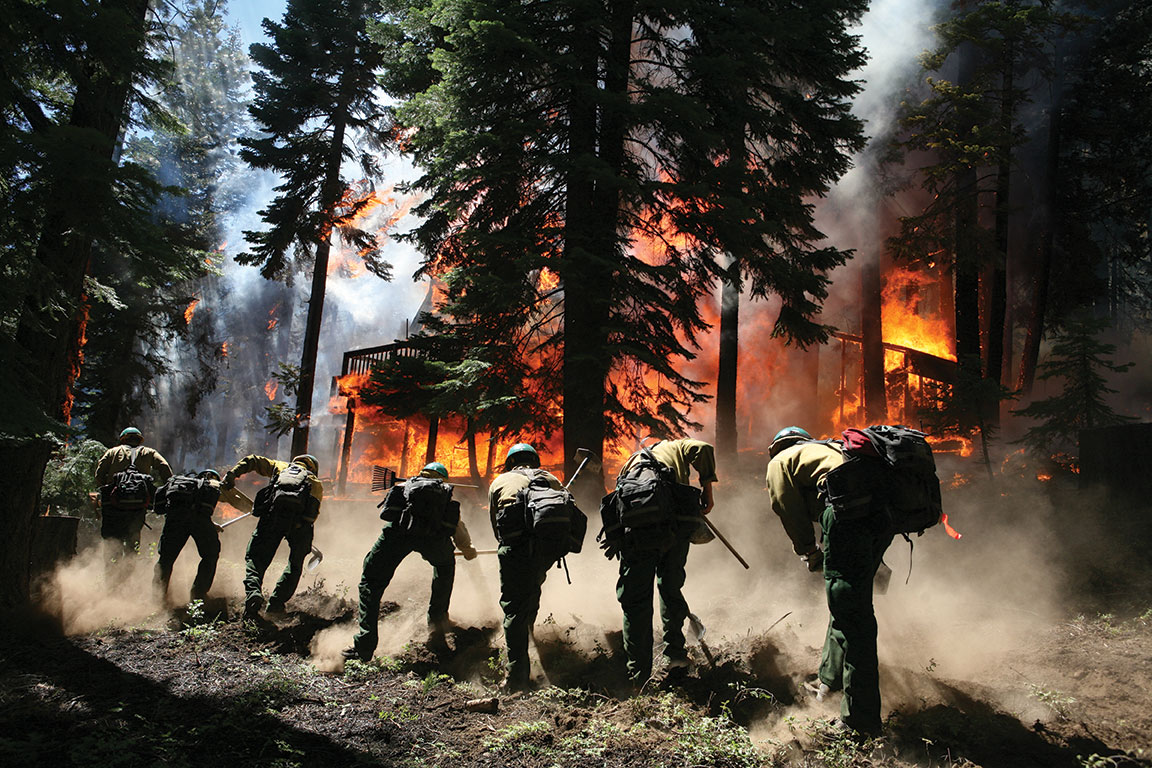
01 Dec The Second Coming of the Flames
Sierra Nevada forests are in the midst of an ecological transformation fueled by record-breaking wildfire and a changing climate—and a 13-year-old Tahoe burn area may hold a glimpse into the state’s future forests

Deciduous trees, glowing in the autumn sun, thrive in the Angora Fire burn zone, photo by Ryan Salm
If you wanted to see what awaits more than 4 million acres of land incinerated by wildfire across California in 2020, you might come to Angora Ridge Road, an undulating ribbon of one-lane asphalt that follows the skyline above Fallen Leaf Lake. You might look to the southeast, down a sea of brush and the skeletal remains of torched trees, and see both glimmers of hope and cause for deep concern.
Fire is the architect of healthy forests and a raging, destructive force that can erase evergreen landscapes generations in the making in a matter of flame-filled minutes. At this South Lake Tahoe vista, you can see both of these aspects of fire at play—the havoc it wreaks and the new life it gives. This duality is a vexing dilemma that has become increasingly difficult to untangle in California. Now, with seasons supercharged by climate change and forests choked by dense thickets of trees, fire has arisen as both the most perilous threat, and a time-tested savior, of California’s forests. How the state balances its need for fire and its fear of flames may shape California’s forests for centuries to come.
“We’ve tied ourselves in quite a knot,” says Craig Thomas, a longtime forest advocate and champion of beneficial wildfire in the Sierra Nevada.
No illustration of the state’s conundrum could have been more jaw-dropping than this year’s wildfire season. California erupted into flames throughout late summer. While the sheer acreage that burned was perhaps not large by long-term historical standards, it was a modern record. Wildfire burned incredibly hot and destructive from Southern California to Mendocino County. The August Complex of fires in Mendocino County reached 1 million acres in size, a never-before-seen scale for a single complex of California fires. The blaze was so large that it necessitated an entirely new term in the fire lexicon—“gigafire.”

This mountainside of dead trees near Shaver Lake, pictured in October 2016, went up in flames in the Creek Fire in September 2020, photo by Sylas Wright
Smoke drew a dark curtain over the sun, blanketing the state in a thick, unhealthy pall for weeks on end. The Creek Fire west of Mammoth and east of Fresno erupted in a landscape of beetle-killed pines, billowing an apocalyptic mushroom cloud of smoke and ash into the sky.
“It looked like an atomic bomb went off,” says Thomas of the Creek Fire. “That is what we are trying to avoid.”
A total of 9,177 wildfires burned across the state in 2020, torching well over 4 million acres. Five out of the top six wildfires in state history burned in 2020, destroying more than 10,000 structures and killing 31 people, according to CalFire.
But the season was really an exclamation point on a string of disastrous wildfire years. Fire, which firefighters and forest managers had worked so hard to eradicate from the landscape for 120 years, had returned with a vengeance—bigger and more damaging than ever. From Santa Rosa to Paradise, Shaver Lake to Mendocino, the sheer power of large-scale wildfire is once again a major natural force shaping the state.
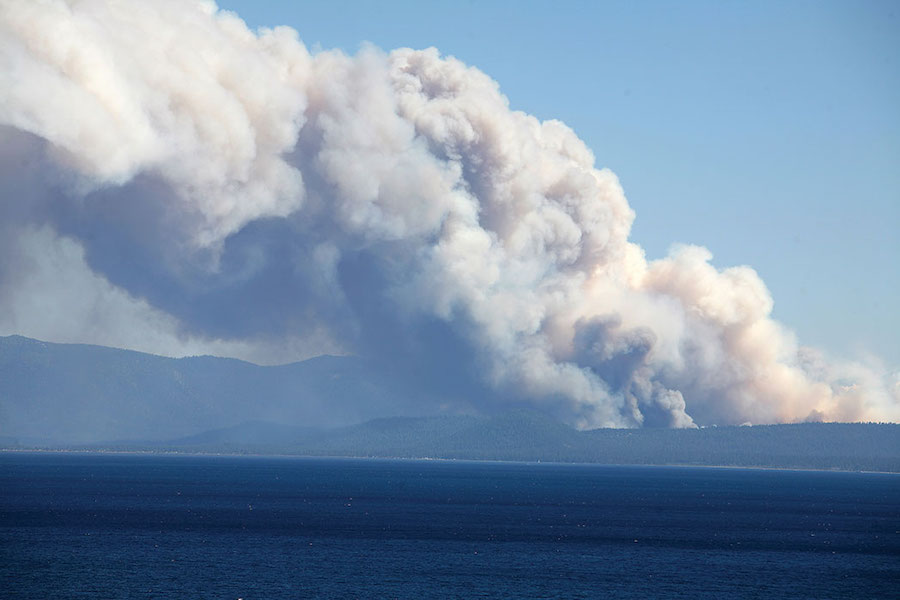
Day one of the 2007 Angora Fire in South Lake Tahoe, as seen from the North Shore, photo by Ryan Salm
Fire’s Return
Forest managers and ecologists admit that eradicating flames from the forest for more than a century was a mistake, and the state is now paying the price for that decades-long blunder. They concede that in the absence of flames—and as a consequence of clear-cut logging and a lack of forest management—a carpet of unnaturally thick forest has grown dense and dangerous. This ticking time bomb now threatens to go off every summer in California until forest managers can defuse the explosive conditions more than a century in the making.
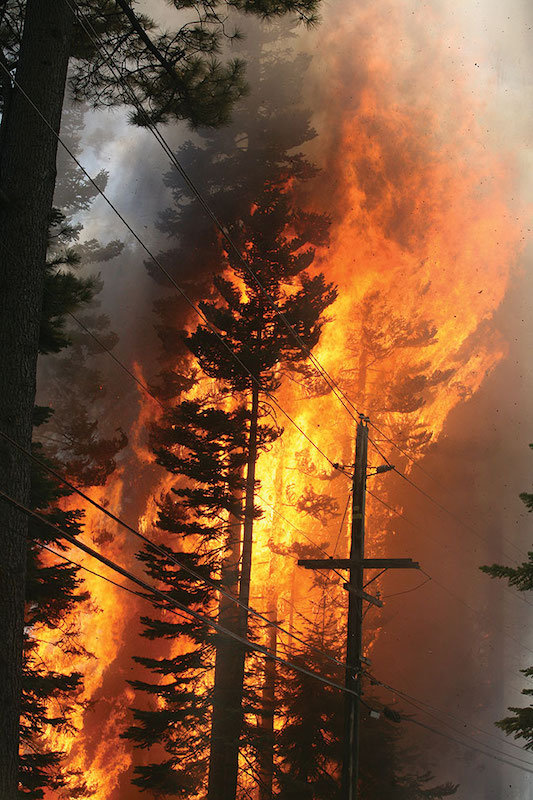
Mature firs and pines go up in flames amid a wildfire in the Lake Tahoe Basin, photo by Ryan Salm
Part of that defusing will be allowing good fire to fight bad fire—returning to a delicate equilibrium that reigned throughout the Golden State for thousands of years before European settlers arrived.
This future of a fire-filled California is both horrible and hopeful. Federal and state agencies recognize they can no longer hold back the flames, and as studies into fire’s critical importance to forests become more and more irrefutable, many are trying to encourage good fire to minimize the inevitable uncontrollable blazes. Forests from the Lake Tahoe Basin Management Unit, which rolled back blanket fire suppression policies in 2009, to the Tahoe National Forest, which is also considering the same move, are exploring ways to re-integrate beneficial fire back into the forest in a way that can ward off devastating future firestorms.
Slowly, forest managers are realizing that fire can be a valuable tool to bring us back from a cycle where too many unnaturally large, devastating wildfires rage, while too few low-intensity, beneficial fires burn.
As stated in a 244-page assessment of yellow pine forests throughout the Sierra Nevada written by Hugh Safford and Jens Stevens: “Because of the high ecological and evolutionary important of frequent fire to the assessment area’s [Yellow Pine/Mixed Conifer] forests, it has been argued that the exclusion of fire from most of the assessment area for the last century is one of the most significant human-caused ecological disturbances currently in play.”
The state has slowly boxed itself in through a century of misunderstanding the environment we inhabit, until we have only one choice—fire. But within that one choice, there is still room to make good decisions, says Thomas.
“Our choices are limited to fire we don’t like and overwhelms us, or fire we have some say over,” says Thomas.
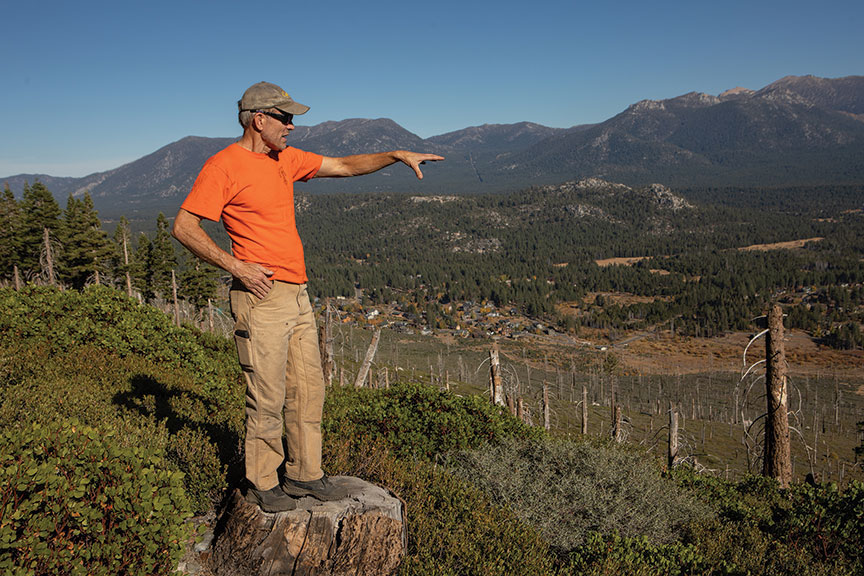
Hugh Safford, the regional ecologist for the U.S. Forest Service’s Pacific Southwest Region, overlooks the mountainside burned in the Angora Fire some 13 years ago, photo by Ryan Salm
Angora 13 Years Later
Hugh Safford wades through a sea of huckleberry oak, mountain whitethorn, green leaf manzanita and bitter cherry. He steps onto a stump poking through the shrubs and looks out at the vast sea of brush that cascades downslope until it reaches a patch of electric orange aspens. The skeletons of torched trees punctuate the hillside like aging, unsteady telephone poles. The 254 homes burned during the Angora Fire, rebuilt in the cul-de-sacs and tree-lined streets below, string out like matchboxes toward central South Lake Tahoe.
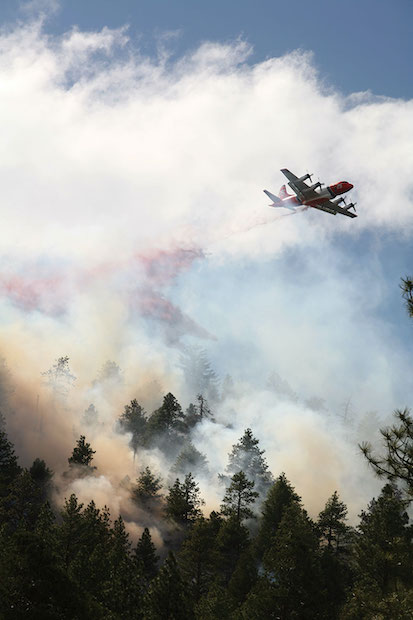
An air tanker drops fire retardant on a blaze in the Tahoe Basin, photo by Ryan Salm
In 2007, this slope burned uncontrollably. Firefighters lined Angora Ridge, desperate to keep the flames from spilling over to the lakeshore homes at Fallen Leaf Lake. Where Safford now stands, a life-and-death drama unfolded as firefighters battled back the flames, assuring that the blaze did not mushroom into something even more sinister and deadly. While the destruction and size of the Angora Fire made it the worst fire in modern Lake Tahoe history, miraculously not a single life was lost.
Safford, the regional ecologist for the U.S. Forest Service’s Pacific Southwest Region, knows landscapes like these well. On a southeast slope after a devastating fire, these are the usual suspects—the opportunistic brush species that thrive on the sunlight and heat that suddenly return after wildfire. They are the first step in a forest’s slow healing process.
No longer shaded by pines and firs, brush seeds spring to life activated by the flames. Like a scab covers a wound, buying the tender area the time and protection to heal back to its natural state, this expanse of shrubs is an evolutionary pre-programmed response to fire.
But if you are looking for evergreen forest, you have to look closely. Halfway down the slope an island of white fir stands clustered together—one of those haphazard products of dumb luck, the flames somehow sparing them while torching the hill on either side.
“If you can somehow keep this site from burning again for another 50 years, you will start to get recruitment of trees out into this big patch out here,” says Safford.
The problem with huge, intense fires—“stand-replacing fires,” as they are often called by forest experts—is they eliminate the mechanisms by which conifers regenerate. With all mature trees incinerated, seeds can only travel so far from the edge of the fire. Some are carried short distances by wind. Others are moved farther by birds and rodents. But conifers, which evolved during an era of moderate fire, are not evolutionarily adapted to regenerate after large-scale catastrophic fire.
“In 50 years you are going to have some low density of small trees and saplings coming up,” says Safford. “But if it burns again, you are going to reset. And the chances of it burning again are pretty high.”
What is happening beyond the surge of shrubs is complicated. Woodpeckers thrive in the dead snags, hollowing out homes that become habitat for mountain bluebirds and rodents. In the evening light, tree swallows flit from tree to tree, and in the bed of Angora Creek, a coyote slinks from willow to willow. Aspens and willows have flourished. In the post-fire tally of winners and losers, conifers have suffered while hardwoods have succeeded. In fall’s changing colors, they stand out as literal bright spots in the burn area— rivers of orange and red, and clusters of yellow.
There are several reasons for this hardwood resurgence. Within Sierra Nevada forests, conifers and hardwoods are locked in a constant battle for resources—a zero-sum game that has tilted toward pines and firs for decades. Whichever species can control sunlight and water wins, and the hungry roots and thick canopies of conifers have left aspen stands to dwindle away for decades.
Fire is the hardwoods’ ally in this battle for dominance. Hardwoods’ method of regeneration, from root stalks, allows them to survive even intense fire, and spring back to life in a landscape of abundant sunlight and water—a world where the coniferous competitor has been eliminated.
While many people think of post-fire forests as ashy and dry, the opposite is actually true. The Angora Burn area turned marshy and soggy in many places after the fire, says Safford. Tens of thousands of evergreens, which each suck and transpire hundreds of gallons of water each day, had suddenly stopped drinking. Water pooled and saturated places that had been dry for generations.
Safford says archeologists have found intriguing reminders that this post-fire abundance of water was perhaps much more common before European settlers arrived. Some burn areas in the Sierra Nevada have allowed long-dormant springs to flow again, and archeologists have uncovered Native American artifacts at the springs, proving that they most likely flowed regularly in an era before logging and wildfire suppression allowed conifers to spread thick and thirsty across the landscape.
The Angora Fire is remarkable in that it is one of the most intensely studied wildfires in recent memory. Its location near the banks of one of the world’s most celebrated alpine lakes made it a laboratory for dozens of researchers and ecologists.
What you see here is a reminder of the resilience of nature in the face of fire, and a stark warning of the generational consequences of catastrophic wildfire. Like the Angora Fire brush field may stay in its shrub state for a generation, some of the areas burned in the Creek Fire may transform into “badlands” and “moonscapes,” says Safford.
“The soil will be powdered. It is really steep land. I bet you they don’t re-seed and it never grows forest again,” says Safford.
It’s a wake-up call that forests—thought of as the ultimate renewable resources that magically regenerated after logging, fire and mismanagement—may change shape or disappear in an age of climate stress and catastrophic wildfire.

Wildfire has played a vital role in the Sierra Nevada’s ecology for centuries, photo by Ryan Salm
Pines in Peril
If you were to concoct a living organism that would struggle mightily to adapt to the potent combination of climate change and catastrophic fire, you might create the pine tree.
Immobile, dependent on seeds to reproduce and so long-lived that they can outlast the climate they germinated in, pines are in peril.
“Trees don’t migrate very quickly. They also don’t evolve very quickly,” says Safford.
A 500-year-old Jefferey pine in Tahoe would have sprouted as Ferdinand Magellan sailed to the Pacific Ocean or as Hernan Cortes took Aztec leader Moctezuma II captive. If it dropped seed to the ground today, its offspring would sprout in an era where the climate and forest conditions are radically different.
“Big, big trees, they are tracking an ancient climate,” says Safford. “They can hang on forever.”
Their offspring, however, can find themselves maladapted to a new world.
In fact, as Safford wrote in his examination of the yellow pine forests’ natural range of variation, even a couple hundred years has changed the forest dramatically.
“[Yellow Pine/Mixed Conifer] forests are greatly changed from the presettlement period, so much so that people from the 18th or 19th centuries would probably not recognize the modern forest,” Safford writes in the study.
The same study points out that those changes to the forest are likely accelerating. One model mentioned in the study illustrates the dramatic impact of climate on the pine forests that cloak the Sierra Nevada.
“By 2099, under the warmest and driest scenario, grassland almost completely replaced shrublands on the Sierra Nevada west slope and also expanded greatly in the California portion of the Great Basin. Broadleaf woodland and forest replaced large areas of evergreen conifer forest under all three scenarios, with fire playing an important role in the transition, especially in the relatively warmer and drier scenarios,” reads the study.
Another model mentioned in the study goes even further. An 800-year forecast of Sierra Nevada forests that the authors admit is “probably very conservative with respect to the velocity of change,” because of how it conservatively models fire behavior and the fact that it doesn’t factor in insect and disease impacts, still predicts a dire future for pine forests. “At the lower two elevations, trees either completely or nearly disappeared by the final century of the simulation,” states the study. The two elevation ranges—5,905 feet and 7,217 feet—are elevations that today are synonymous with evergreen-clad mountain peaks.
The changes are so significant that ecologists like Safford are questioning the common ecological practice of looking backwards to historical forest conditions as a base on which to establish forest management practices.
“In preparing forests for changing climatic conditions, the value of historical ecology is the insight it provides into ‘the way things work’ rather than ‘the ways things were,’” reads a chapter of Managing Sierra Nevada Forest authored by Safford, Malcolm North and M.D. Meyer.
This concept is particularly reasonable considering that old-growth pine forests grew up in a period of the Holocene (the last 12,000 years) called the Little Ice Age that was particularly cool and wet.
“The period between 1650 and 1850 was the coolest since the Early Holocene. Glaciers expanded in the Sierra Nevada, tree line dropped, and fire frequencies moderated,” writes Safford and Stevens in their yellow pine forest assessment. “It is important to underline that the period of the Little Ice Age is also the period most commonly used as an historical reference period for restoration planning in the Western United States.”
Instead of looking back, some forest researchers like Derek Young are looking forward to hotter, drier conditions.
Young, a researcher at U.C. Davis, has been testing the success of lower-elevation trees transplanted into higher elevation burn areas across California. The lower-elevation seedlings, adapted to hotter, drier conditions, are displaying some success in growing back the forests that once covered the burned areas. And perhaps they will be better adapted to withstand the rising temperatures and drier soils that climate change is forecasted to bring.
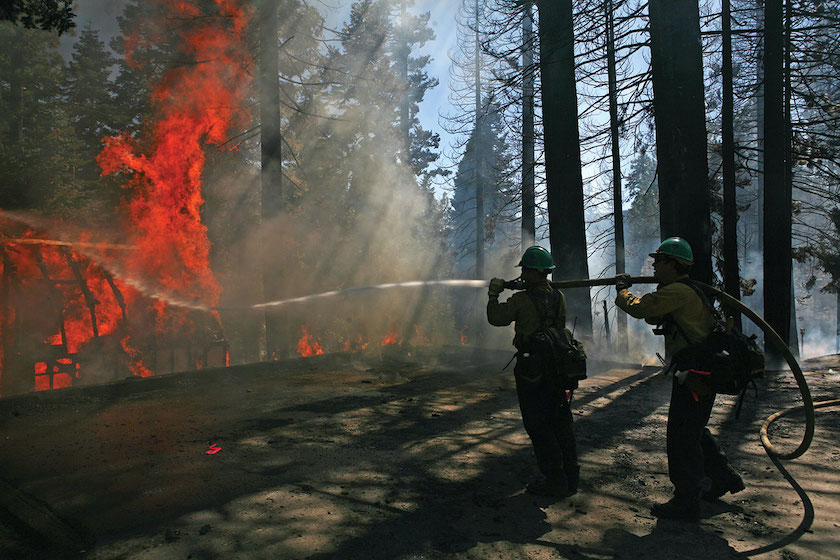
Firefighters salvage the remains of a Tahoe home, photo by Ryan Salm
Future Fires, Future Forests
If the Angora Fire is any indication, large swaths of the Sierra Nevada might never look the same after this year. Some slopes that were carpeted by evergreens will likely transform into brush fields or grasslands. Others that burned less severely may bounce back stronger and more vibrant than ever.
Thomas is anxious to see the fire severity maps, to see what may have burned too hot to regenerate, and what areas may have survived to seed the next generation of Sierra forest.
But then there is next summer and the summer after that. More seasons that threaten catastrophic fire. More seasons where the ticking time bomb of unnaturally thick forest and increasingly hot and dry conditions threaten more disastrous wildfire seasons like 2020.
Thomas and Safford believe that California forests desperately need more fire. Prescribed, controlled fire. Fire in the spring and fall, and on days of lower fire danger. Fire that burns more like it did 200 years ago.
Embracing fire, like Native Americans did for thousands of years, and using it to our advantage, is the easiest way to solve this seemingly intractable problem.
“We’re still trying to get people to understand fire’s value,” says Thomas.
Thomas has been saying these things for three decades, since founding Sierra Forest Legacy, a science-based forest issues nonprofit.
“For 30 years we have been pounding on the door saying fire is going to express itself in a way that is either beneficial or horrid,” says Thomas. “It is not perfect. But I try to tell people, ‘How is what we are doing now working for us?’”
For years now Thomas has seen hundreds of millions of dollars poured into fire suppression—money that is necessary and critical—while almost nothing is spent on actually solving the root of the wildfire problem. Each year the same rhetorical question arises.
“Can we not get in front of this? Apply new resources, focus and people? Or are we just going to do damage control?” asks Thomas.
Like pine trees slow to adapt to this resurgence of widespread wildfire, humans have been slow to react as wildfires continue to burn towns, torch entire forests and destroy ecosystems. Now, Californians and residents across the American West face a choice. Angora and the record-breaking fires of 2020 can serve as hard lessons that force us to adapt and change and innovate—to mold our forest using the time-tested natural processes of the past and the innovative forestry methods of the future. Or we can keep fighting fire each year, battling ever-increasing climate-fueled blazes that reshape our forests and overwhelm our firefighters.
Thomas, now 74, a veteran of how slow these forest issues materialize from idea into action, is still betting that we can meet the challenge.
“I refuse to give up on it,” he says. “I have to believe that humans can learn, adapt and change. That is the only way I can live in this world.”
Perhaps that resilience—both in the natural world and the human mind—is our forests’ greatest hope.
David Bunker watched flames engulf South Lake Tahoe neighborhoods as a newspaper reporter covering the Angora Fire in 2007. He’s covered forest issues in Tahoe off and on for the last 17 years.




No Comments